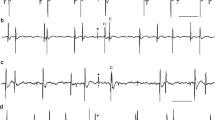Abstract
We have attempted to reconcile the different patterns of distribution of interspike intervals that are found in motoneurones made to discharge by intracellular injection of constant current in reduced animal preparations and by voluntary control in human subjects. We recorded long spike trains from single motor units in three human muscles made to discharge at constant mean frequencies with the help of auditory and visual feedback. The distribution of interspike intervals in each spike train was analysed quantitatively. We found that the different pattern of discharge of the human motor units could be accounted for when due allowance was made for the variability of the drive to the human motoneurone which arose because of the feedback process used to maintain the target frequency. A model testing this hypothesis gave results that were qualitatively consistent with the human data.
Similar content being viewed by others
References
Ashby P, Zilm D (1982) Relationship between EPSP shape and crosscorrelation profile explored by computer simulation for studies on human motoneurons. Exp Brain Res 47:33–40
Calvin WH (1974) Three modes of repetitive firing and the role of threshold time course between spikes. Brain Res 69:341–346
Calvin WH, Stevens CF (1968) Synaptic noise and other sources of randomness in motoneuron interspike intervals. J Neurophysiol 31:574–587
Derfler B, Goldberg LJ (1978) Spike train characteristics of single motor units in the human masseter muscle. Exp Neurol 61:592–608
Derksen HE (1965) Axon membrane voltage fluctuations. Acta Physiol Pharmacol Neerl 13:73–76
Fetz EE, Gustafsson B (1983) Relation between shapes of post-synaptic potentials and changes in firing probability of cat motoneurones. J Physiol 341:387–410
Fienberg SE (1974) Stochastic models for single neuron firing trains: a survey. Biometrics 30:399–427
Gerstein GL, Mandelbrot B (1964) Random walk models for the spike activity of a single neuron. Biophys J 4:41–68
Gustafsson B (1974) Afterhyperpolarization and the control of repetitive firing in spinal neurons of the cat. Acta Physiol Scand Suppl 416:1–47
Gustafsson B, McCrea D (1984) Influence of stretch-evoked synaptic potentials on firing probability of cat spinal motoneurons. J Physiol 347:431–451
Kostyukov AI (1978) Curve-crossing problem for Gaussian stochastic process and its application to neural modelling. Biol Cybern 29:187–191
Kostyukov AI, Ivanov YN, Kryzanovsky MV (1981) Probability of neuronal spike initiation as a curve-crossing problem for Gaussian stochastic processes. Biol Cybern 39:157–163
Kranz H, Baumgartner G (1973) Human alpha motoneurone discharge, a statistical analysis. Brain Res 67:324–329
Matthews PBC, Stein RB (1969) The regularity of primary and secondary muscle spindle afferent discharges. J Physiol 202:59–82
Midroni G, Ashby P (1989) How synaptic noise may affect crosscorrelations. J Neurosci Methods 27:1–12
Perkel DH (1970) Spike trains as carriers of information. In: Schmitt FO (ed) The neurosciences-second study program. Rockefeller University Press, New York, pp 587–596
Person RS, Kudina LP (1972) Discharge frequency and discharge pattern of human motor units during voluntary contraction of muscle. EEG Clin Neurophysiol 32:471–483
Schwindt PC (1973) Membrane-potential trajectories underlying motoneuron rhythmic firing at high rates. J Neurophysiol 36:434–449
Schwindt PC, Calvin WH (1972) Membrane-potential trajectories between spikes underlying motoneuron firing rates. J Neurophysiol 35:311–325
Schwindt PC, Crill WE (1982) Factors influencing motoneuron rhythmic firing: results from a voltage-clamp study. J Neurophysiol 48:875–890
Shiavi R, Negin M (1975) Stochastic properties of motoneuron activity and the effect of muscular length. Biol Cybern 19:231–237
Stein RB (1965) A theoretical analysis of neuronal variability. Biophys J 5:173–194
Stein RB, Lee RG (1981) Tremor and clonus. In: Brooks VB (ed) Handbook of Physiology, Sect 1. The nervous system, Vol II. Motor control. American Physiological Society, Bethesda, pp 325–344
Warren JD, Miles TS, Türker KS (1993) Properties of synaptic noise in tonically-active human motoneurons. J EMG Kinesiol 2:189–203
Author information
Authors and Affiliations
Rights and permissions
About this article
Cite this article
Poliakov, A.V., Miles, T.S. & Nordstrom, M.A. Discharge patterns of tonically firing human motoneurones. Biol. Cybern. 73, 189–194 (1995). https://doi.org/10.1007/BF00204057
Received:
Accepted:
Issue Date:
DOI: https://doi.org/10.1007/BF00204057




